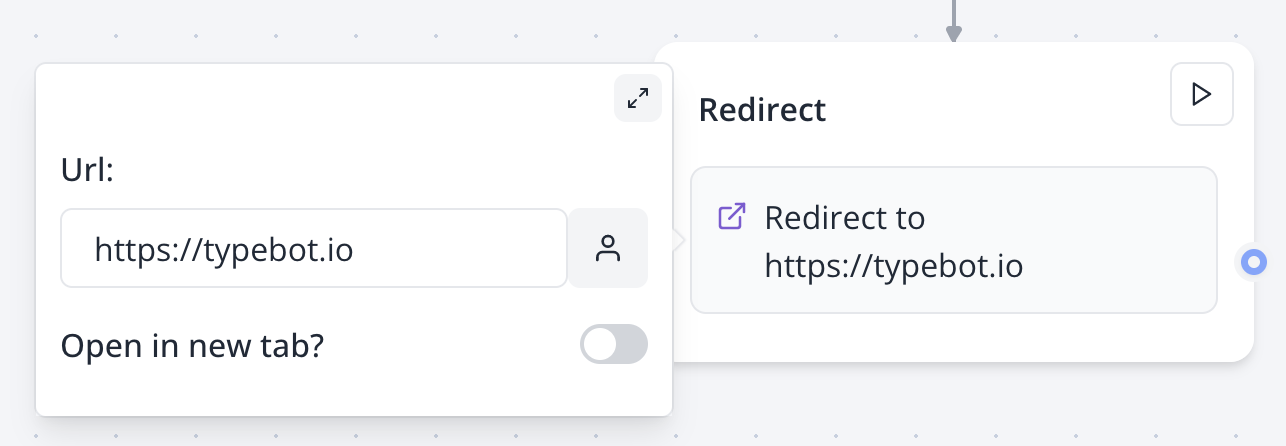The Redirect logic block allows you to redirect users to external URLs either in the current tab or a new tab, enabling seamless integration with external services and websites.
Safari and iOS devices will block a redirect in a new tab by default so a popup will be displayed
to the user. Make sure to test your redirect logic block on these devices.
Configuration Options
URL Settings
- Target URL: Specify the destination URL for redirection
- Variable Support: Use variables to create dynamic URLs based on user data
- Validation: Ensures proper URL formatting for successful redirection
- Protocol Handling: Automatically handles HTTP/HTTPS protocols
Navigation Behavior
- Current Tab: Redirects in the same browser tab (default behavior)
- New Tab: Opens the URL in a new browser tab or window
- Cross-Platform Support: Works across web, mobile web, and embedded environments
Features
Dynamic URL Construction
Build personalized redirect URLs using variables:
- User Data Integration: Include user information in URLs (e.g.,
https://example.com/user/{{User ID}})
- Parameter Passing: Pass form responses as URL parameters
- External System Integration: Direct users to external dashboards with context
Flexible Navigation Options
- Same Tab Redirect: Seamless transition for completing workflows
- New Tab Opening: Keep the conversation open while accessing external resources
- Context Preservation: Maintain bot session when opening in new tabs
- Web Browsers: Full support across all modern browsers
- Mobile Devices: Optimized for mobile web experiences
- Embedded Environments: Works within iframe and embedded implementations
Advanced Features
Conditional Redirecting
- Variable-Based Logic: Redirect to different URLs based on user responses
- A/B Testing: Use with A/B test blocks to redirect users to different landing pages
- Personalization: Create personalized redirect experiences based on user data
External System Integration
- CRM Integration: Direct users to personalized CRM portals
- Payment Processing: Redirect to payment gateways with pre-filled information
- Third-party Dashboards: Link to external analytics or reporting tools
- Document Systems: Direct to specific documents or resources
Analytics and Tracking
- UTM Parameter Support: Add tracking parameters for analytics
- Campaign Tracking: Monitor redirect performance and user behavior
- Conversion Tracking: Measure success rates of redirect-based flows
Best Practices
URL Construction
- Absolute URLs: Always use complete URLs (https://example.com) rather than relative paths
- Parameter Encoding: Properly encode variable values in URLs
- Security Validation: Validate and sanitize user input used in URLs
- HTTPS Protocol: Use secure HTTPS URLs whenever possible
User Experience
- Clear Intent: Make redirect purpose clear to users before redirecting
- Loading Indicators: Provide feedback during redirect processes
- Fallback Options: Have alternatives if redirects fail
- Return Navigation: Consider how users will return to the conversation
- Mobile Optimization: Ensure target URLs are mobile-friendly
- App Integration: Consider how redirects work within mobile apps
- Popup Blockers: Account for browser popup blocking behavior
- Network Conditions: Handle slow network connections gracefully
Security Considerations
- URL Validation: Validate URLs to prevent malicious redirects
- Domain Whitelisting: Consider restricting redirects to trusted domains
- User Consent: Inform users before redirecting to external sites
- Data Privacy: Be mindful of data passed in URL parameters
Troubleshooting
Common Redirect Issues
- Invalid URLs: Ensure URLs are properly formatted with protocols
- Variable Errors: Check that variables contain valid URL components
- Encoding Problems: Properly encode special characters in URLs
- Protocol Mismatches: Verify HTTP/HTTPS protocol consistency
Browser-Specific Problems
- Popup Blockers: New tab redirects may be blocked by popup blockers
- Safari Limitations: iOS Safari has strict popup blocking policies
- CORS Issues: Some embedded environments may restrict redirects
- Mobile Browsers: Different behavior between mobile and desktop browsers
- Mobile Apps: Redirects may behave differently in WebView components
- Iframe Restrictions: Some sites prevent iframe-based redirects
- Third-party Blockers: Ad blockers or privacy tools may interfere
- Network Firewalls: Corporate networks may block certain redirects
Integration Problems
- External System Failures: Handle cases where target sites are unavailable
- Authentication Issues: Manage expired or invalid authentication tokens
- Parameter Handling: Ensure external systems properly receive passed parameters
- Session Management: Maintain proper session state across redirects


